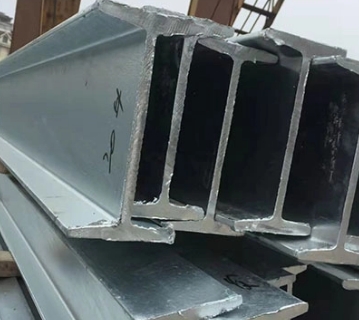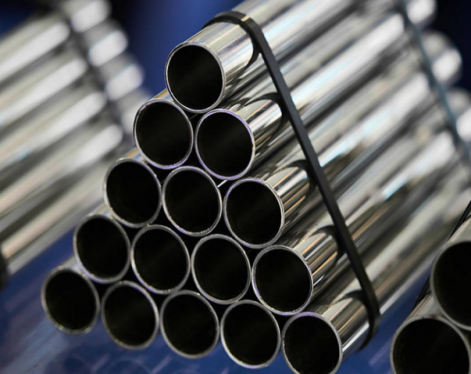1. The two forms of h beam
H Beam has two production methods: hot rolling forming and welding combined forming.
Hot-rolled h shaped steel: wide flange, large lateral stiffness; strong bending resistance, about 5 to 10% higher than I beam, the two surfaces of the flange are parallel to each other, and the structure is convenient.
Welding H beam: For example, high-frequency welding of H beam relies on high-frequency current to partially melt and weld the metal itself, without the need for welding wire or flux. It can be produced continuously at high speed, with high output and easy to realize mechanization and automation. The same cross-section has excellent cross-sectional properties.
2.Advantages of hot-rolled h beam and welding h section
(1) Hot-rolled H beam: scientific and reasonable structure, good plasticity and flexibility, high structural stability, suitable for building structures that can withstand large vibration and impact loads, strong resistance to natural disasters; convenient for mechanical manufacturing, intensive production, high precision High, easy to install, and easy to guarantee quality, it can be built into a real house manufacturing factory, bridge manufacturing factory, industrial plant manufacturing factory, etc. The development of steel structures has created and promoted the development of hundreds of emerging industries.
(2) Welded H beam: It can be processed, designed and combined arbitrarily according to the project, and special specifications can be manufactured to meet the actual needs of special projects; H beam specifications are economically designed, and their section moment, section coefficient, pressure resistance, The load-bearing capacity is much higher than that of hot-rolled steel with the same unit weight.
3.Hot-rolled h beam vs welding h section
When the specifications and materials are the same, hot-rolled H beam can completely replace welded H beam, and the former is of better quality than the latter. Generally speaking, in structural design, hot-rolled H beam should be used for high-rise buildings. For light steel factory buildings with portal rigid frame structures, welded variable-section H beam should be used. The steel quantity index is better, but the project cost cannot The reason for the savings is that the processing volume of hot-rolled H beam is smaller and the construction period is slightly shorter. If the comprehensive economic benefits (including after the project is put into use) are calculated, and the construction period plays a decisive role, hot-rolled H beam can be selected. However, when the construction period requirements are not strict or there are some image projects, welded H beam can be selected based on the principle of saving resources.
Welding H beam is to cut strip steel with appropriate thickness into appropriate width, and weld the edges and waist together on a continuous welding unit. Welding H beam has the disadvantages of high metal consumption, low economic efficiency of production, and difficulty in ensuring uniform product performance. Therefore, H-beam production is mainly based on rolling method.
The main difference in rolling between H beam and ordinary I-beam is that the latter can be rolled in a two-roller pass, while the former needs to be rolled in a universal pass. Hot-rolled H-beams produced using near-net-shape continuous-cast profile billets and four-roll universal rolling processes have outstanding features such as high quality, high efficiency, low consumption, and low cost. They have huge potential in improving the quality of steel materials and improving the economic benefits of use. superiority.

3.Hot-rolled h-shaped steel vs welding h section
When the specifications and materials are the same, hot-rolled h-shaped steel can completely replace welded h-shaped steel, and the former is of better quality than the latter. Generally speaking, in structural design, hot-rolled H-shaped steel should be used for high-rise buildings. For light steel factory buildings with portal rigid frame structures, welded variable-section H-shaped steel should be used. The steel quantity index is better, but the project cost cannot The reason for the savings is that the processing volume of hot-rolled H-shaped steel is smaller and the construction period is slightly shorter. If the comprehensive economic benefits (including after the project is put into use) are calculated, and the construction period plays a decisive role, hot-rolled H-shaped steel can be selected. However, when the construction period requirements are not strict or there are some image projects, welded H-shaped steel can be selected based on the principle of saving resources.Welding H-shaped steel is to cut strip steel with appropriate thickness into appropriate width, and weld the edges and waist together on a continuous welding unit. Welding H-shaped steel has the disadvantages of high metal consumption, low economic efficiency of production, and difficulty in ensuring uniform product performance. Therefore, H-beam production is mainly based on rolling method.
The main difference in rolling between H-shaped steel and ordinary I-beam is that the latter can be rolled in a two-roller pass, while the former needs to be rolled in a universal pass. Hot-rolled H-beams produced using near-net-shape continuous-cast profile billets and four-roll universal rolling processes have outstanding features such as high quality, high efficiency, low consumption, and low cost. They have huge potential in improving the quality of steel materials and improving the economic benefits of use. superiority.
| Comparison Category | Hot-Rolled H-Beam | Welded H-Beam |
|---|---|---|
| Manufacturing Process | Single piece of metal shaped while red-hot | Assembled on-site by connecting and welding plates |
| Uniformity and Quality | High uniformity in mechanical properties | Can vary due to welding quality |
| Economic Efficiency | High efficiency, low material waste | Lower labor and material consumption |
| Customization | Limited to standard sizes | Can be tailored to specific project requirements |
| Suitable for Large Orders | Preferred for large-scale projects | More flexible for smaller or bespoke projects |
| Material and Labor Usage | Uses fewer raw materials, efficient for large orders | Potentially less labor-intensive and material-efficient |
| Performance Characteristics | Reliable and consistent performance | May have variability; can achieve unique specifications |
| Defects and Uniformity | Less prone to defects due to uniform manufacturing | Prone to welding defects if not controlled meticulously |
| Flexibility in Steel Grades | Typically Q235B and Q345B | Allows for a wider selection of steel grades |
| Precision and Surface Quality | High precision and good surface finish | Depends on the quality of the welding process |
| Internal Structure | Reliable and stable due to stringent process controls | Structure can vary due to welding |
| Suitability for Applications | Ideal for uniform, large-scale construction | Suitable for custom designs and non-standard sizes |
| Economic Benefit | Cost-effective at scale with consistent quality | May offer economic benefits for smaller or specific projects |









